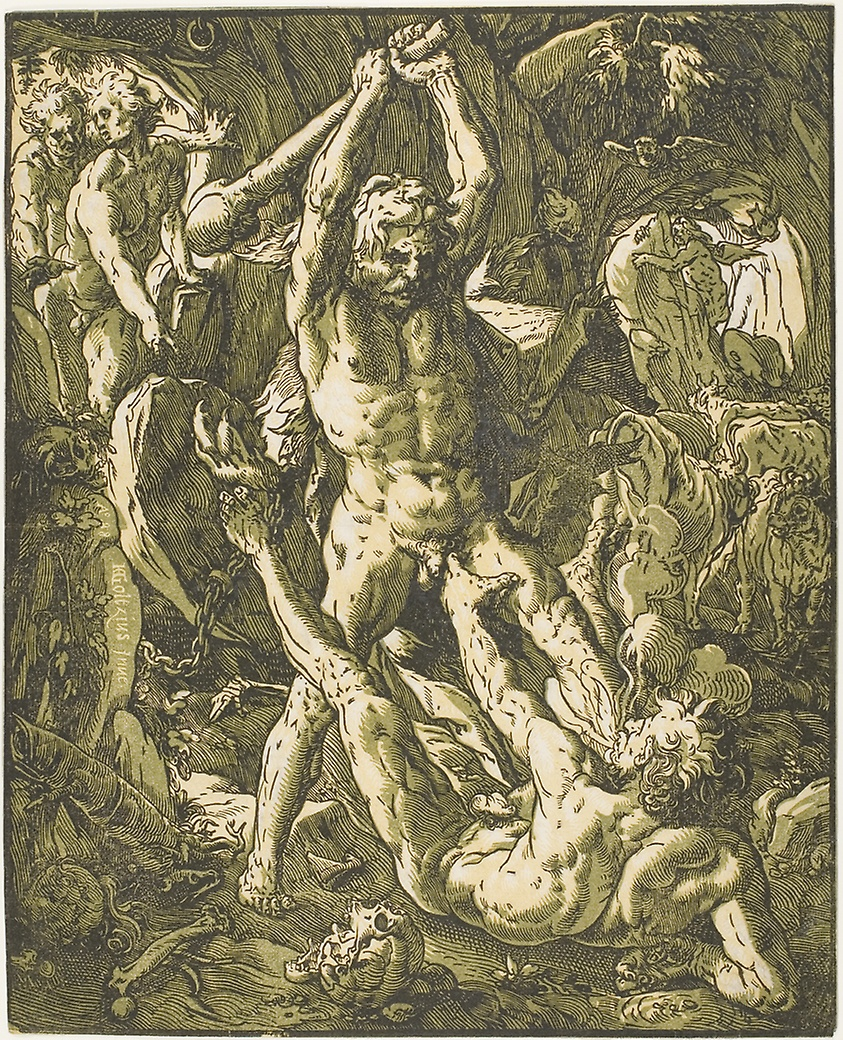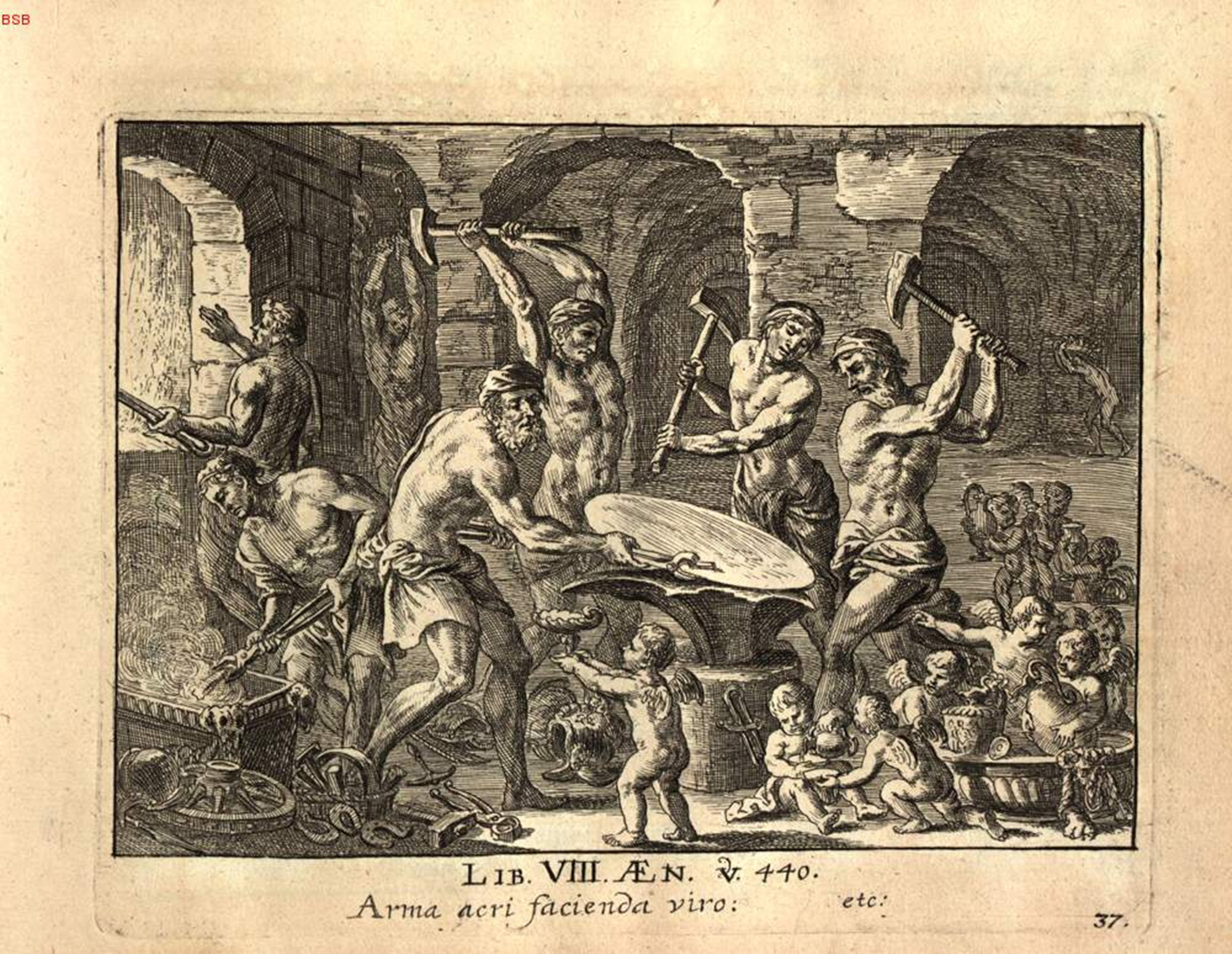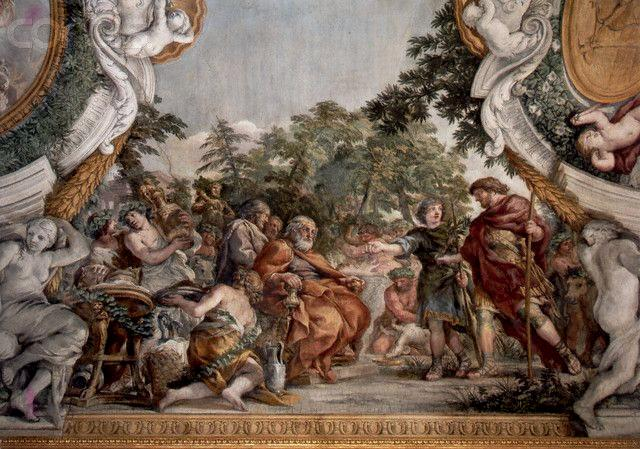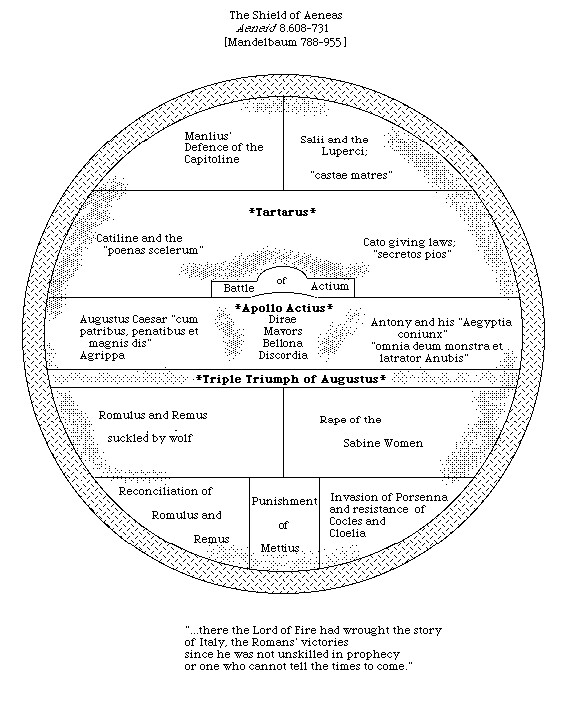Browse By Unit
Jack Marso
Riya Patel
Mick Polito
Jack Marso
Riya Patel
Mick Polito
Book VIII of Vergil's Aeneid: The Future Sight of Rome
Book VIII along with Book XII (which we'll review next) isn't required to be read and translated in Latin. Fortunately for AP Latin students finishing up the last unit, this only has to be read and analyzed in English.
Let’s break down these sections in order to understand Roman cultural and political ideals from the work.
This resource shown below features the Latin translation, reading assistance tools, and commentary in order to help readers easily comprehend and break apart the text for context. Don't worry if that seems a bit unmanageable though, we'll break down everything you need to know nicely below.
👉Read: AP Latin - Vergil Classics
More Contextualization
Nobody likes to do any other work besides what’s required for an exam. However, we want to emphasize how IMPORTANT it is to fully comprehend Book VIII and Book XIII. Because of that, we recommend taking a look at the summary and reviewing each pairing of lines for a more in-depth review of Book VII so that you don't get lost.
👉Read: AP Latin - Book 7 Summary
This is a LARGE book in the Aeneid collection, so it's important that as you read these lines within this book, you identify references to Roman culture, history, and mythology along with other perspectives of Roman culture in order to review Reading and Comprehension and Textual Analysis skills.
👉Read: AP Latin - Book 8 Summary
Alright, let's get into this already!
Breakdown of Book VIII
- Book VII begins already being action-packed as Latium decides on war against the Trojan people. The “wars [Aeneas] must soon fight'' becomes clear to the readers. The main leaders of people of Latinum: Messapus, Ufens, and Mezentius, prepare their armies while Diomedes requests assistance in defense of the Trojans.
- Aeneas understands the circumstances of what’s going on and believes that he must find an ally, too. During sleep, the river god, Tiberinus, explains his next course of action, but Tiberinus also explains that Aeneas first must spot the white sow and her thirty piglets, which Aeneas would later use as a sacrifice for the sake of safety while he searched for an ally. Tiberinus states Aeneas’s ally is King Evander from Pallantium, the future site of Rome.
- Two Trojan ships set out and locate him when Evander’s son, Pallas, greets them. Evander receives Aeneas’s message about the current situation in Italy, ultimately promising to assist. In the aftermath of his acceptance, Evander invites Aeneas, who sat in the seat of honor, and the Trojans to a feast in honor of Hercules’s death in defeating Cacus.
- In summary, a monster named Cacus, the son of Vulcan, stole four bulls and cattle of Geryon from Hercules and led them back by their tails to his cave. Hercules heard one cow bellow as he was leaving, grabbed his weapons, and took off for Cacus’s cave. Hercules tore off his roof, but in defense, Cacus emitted black smoke to fill up the cave. Hercules grabbed him by the throat and choked him to death. As a result, that sacred site is honored because of his heroic actions.

Hercules killing Cacus in his cave after stealing from Geryon. Image Courtesy of Art Institute Chicago
- The feast winds down to the members praying to the gods and commemorating Hercules for all of his actions and accomplishments during his life. Then, Evander begins to speak about his great city.
- He begins by touching upon the inhabitants of the location: The Nymphs and The Fauns, the Golden Age of Latium during Saturn’s rule, along with Tiberinus and Evander’s presence in the city after dying and becoming exiled from their land, respectively. Evander continues by showing a gate built in honor of his mother, Carmentis, and the cave where Romulus will be liberated, Lupercal. After climbing up the Capitoline Hill, where the temple of Jupiter will later be built, Vergil humorously adds the last descriptive sight of the tour: Evander’s scanty home.
- As the humans go to sleep, the conversation shifts toward the gods: Aeneas’s mother, Venus, and her husband, Vulcan. Venus asks the god of metalworking for weapons in supply for Aeneas during his time in Italy and recalls when she didn’t ask of his assistance when Aeneas was in Troy. Although Vulcan wasn’t allowed to make weapons when Troy was still standing, he is played by Venus’s loving touch and agrees to produce as many weapons as he can for Aeneas.
- Vulcan begins to work early at Vulcania, an island just off of Sicily. Vulcan’s work ethic is described as that of “a tireless woman” tending to her “unfinished work.” Vulcan is met by the Cyclopes that also work there supplying lightning bolts, a chariot and a breastplate imprinted with Medusa’s head for the gods, but is ordered to drop that demand of work in favor of the Trojans. A seven-layered shield is created.

Vulcan and the Cyclopes creates the shield utilized by Aeneas and visualized later by Vergil later in the Book. Image Courtesy of Munich Digitization Center.
- In the morning, Evander addresses Aeneas about allying with the Trojans. Evander also opens up the opportunity that the Etruscans can assist the Trojans in the war as well. He speaks about how the Etruscans were once ruled ruthlessly by Mezentius, one of the three main leaders of Latinum. The Etruscans revolted against his tyrannical reign, and he fled to the powerful King of Rutuli, Turnus.
- The Etruscans were informed by a prophet that they were to be ruled by a foreign leader, and Tarchon, a founder of the Etruscan League, questioned if the prophet referred to either Evander or Pallas. Evander rules himself out by signs of age and Pallas is only of half-born descent, leaving Aeneas the only true match left.
- As Aeneas still questions the validity, Evander grants Pallas's and Pallantium's troops to Aeneas. The concern of being the leader is answered: Venus sends a lightning bolt, symbolizing the signs and beginnings of war. One ship is sent back to Ascanius, and sacred rites are performed to honor the gods and provide protection to Aeneas’s allies within the war. Evander is nervous and questions the thoughts of war and the future, and hugs Pallas as the one fleet of the Trojan army heads off for Etruria.

Aeneas, King Evander, and Pallas are depicted. Evander sends off his son and soldiers to help Aeneas assist in the war effort as Aeneas answers the prophecy. Image Courtesy of Sutori
- Aeneas and his companions arrive at Caere, where Venus appears with weapons for Aeneas. The weapons include a helmet, breastplate, sword, greaves, and spears. The shield details a wide variety of Roman cultural aspects. Some features on the shield encompass Romulus and Remus, the brothers that ultimately would found Rome, Titus Tatius, and the Sabine women, who were inter-connected due to the Rape of the Sabine Women and their intervention to end a war that would weaken both sides.
- The shield also has a depiction of the punishment of Mettius, who betrayed the Romans in battle and was torn by chariots riding in two opposite directions. It depicts an Etruscan king named Lars Porsenna, surrounding Rome only to stopped by Horatius Cocles, who famously defended the bridge Pons Sublicius from an invading Etruscan army, and Cloelia, who fled Roman hostage when given during a peace treaty in the Roman-Etruscan Wars.
- Manlius’s depiction follows a different story: when amid the Gallic invasion of Rome, he held out a small garrison in Rome when everyone else had already abandoned it, ultimately overwhelming the Gallic assailants during their attempt to scale the Capitoline hill.

A detailed and insightful representation of Aeneid's shield. Image Courtesy of Flickr
- Furthermore, the shield contained the Salii, or the twelve “leaping priests” of Mars, the Luperci, or “brothers of the wolf” priests, and the punishment of Cataline, who attempted to overthrow the Roman republic and the aristocratic Senate during the Second Catilinarian conspiracy.
- In the middle of the shield lies the Battle of Actium, which was the last war of the Roman Republic fought between Octavian (later to be known as Augustus) and the opposition consisting of forces led by the Egyptian Queen, Cleopatra, and a member of the Second Triumvirate, Mark Antony.
- In the same scene, Agrippa, a lieutenant and close-friend to Octavian during this Battle, face off in one fleet against Mark Antony’s fleet, with Cleopatra’s entering the fray as well. Romans gods are battling Egyptian gods as the waters become tainted with blood. Cleopatra surrenders, as death nears closer, and Octavian has now been pronounced Augustus Caesar as he takes control of a newly established Roman Empire after this prominent victory.
- This scene is graphically more visual than the other images, since Vergil experienced this battle during his lifetime, as the battle took place in 32 BCE and Vergil started writing the Aeneid in 29 BCE. Lastly, although Aeneas is clueless about these images referring to events tht have not yet happened, he’s amazed and lifts that shield, ready for war.
Alright, that's Book VIII! One more section to go before we're done reviewing AP Latin!
<< Hide Menu
Jack Marso
Riya Patel
Mick Polito
Jack Marso
Riya Patel
Mick Polito
Book VIII of Vergil's Aeneid: The Future Sight of Rome
Book VIII along with Book XII (which we'll review next) isn't required to be read and translated in Latin. Fortunately for AP Latin students finishing up the last unit, this only has to be read and analyzed in English.
Let’s break down these sections in order to understand Roman cultural and political ideals from the work.
This resource shown below features the Latin translation, reading assistance tools, and commentary in order to help readers easily comprehend and break apart the text for context. Don't worry if that seems a bit unmanageable though, we'll break down everything you need to know nicely below.
👉Read: AP Latin - Vergil Classics
More Contextualization
Nobody likes to do any other work besides what’s required for an exam. However, we want to emphasize how IMPORTANT it is to fully comprehend Book VIII and Book XIII. Because of that, we recommend taking a look at the summary and reviewing each pairing of lines for a more in-depth review of Book VII so that you don't get lost.
👉Read: AP Latin - Book 7 Summary
This is a LARGE book in the Aeneid collection, so it's important that as you read these lines within this book, you identify references to Roman culture, history, and mythology along with other perspectives of Roman culture in order to review Reading and Comprehension and Textual Analysis skills.
👉Read: AP Latin - Book 8 Summary
Alright, let's get into this already!
Breakdown of Book VIII
- Book VII begins already being action-packed as Latium decides on war against the Trojan people. The “wars [Aeneas] must soon fight'' becomes clear to the readers. The main leaders of people of Latinum: Messapus, Ufens, and Mezentius, prepare their armies while Diomedes requests assistance in defense of the Trojans.
- Aeneas understands the circumstances of what’s going on and believes that he must find an ally, too. During sleep, the river god, Tiberinus, explains his next course of action, but Tiberinus also explains that Aeneas first must spot the white sow and her thirty piglets, which Aeneas would later use as a sacrifice for the sake of safety while he searched for an ally. Tiberinus states Aeneas’s ally is King Evander from Pallantium, the future site of Rome.
- Two Trojan ships set out and locate him when Evander’s son, Pallas, greets them. Evander receives Aeneas’s message about the current situation in Italy, ultimately promising to assist. In the aftermath of his acceptance, Evander invites Aeneas, who sat in the seat of honor, and the Trojans to a feast in honor of Hercules’s death in defeating Cacus.
- In summary, a monster named Cacus, the son of Vulcan, stole four bulls and cattle of Geryon from Hercules and led them back by their tails to his cave. Hercules heard one cow bellow as he was leaving, grabbed his weapons, and took off for Cacus’s cave. Hercules tore off his roof, but in defense, Cacus emitted black smoke to fill up the cave. Hercules grabbed him by the throat and choked him to death. As a result, that sacred site is honored because of his heroic actions.

Hercules killing Cacus in his cave after stealing from Geryon. Image Courtesy of Art Institute Chicago
- The feast winds down to the members praying to the gods and commemorating Hercules for all of his actions and accomplishments during his life. Then, Evander begins to speak about his great city.
- He begins by touching upon the inhabitants of the location: The Nymphs and The Fauns, the Golden Age of Latium during Saturn’s rule, along with Tiberinus and Evander’s presence in the city after dying and becoming exiled from their land, respectively. Evander continues by showing a gate built in honor of his mother, Carmentis, and the cave where Romulus will be liberated, Lupercal. After climbing up the Capitoline Hill, where the temple of Jupiter will later be built, Vergil humorously adds the last descriptive sight of the tour: Evander’s scanty home.
- As the humans go to sleep, the conversation shifts toward the gods: Aeneas’s mother, Venus, and her husband, Vulcan. Venus asks the god of metalworking for weapons in supply for Aeneas during his time in Italy and recalls when she didn’t ask of his assistance when Aeneas was in Troy. Although Vulcan wasn’t allowed to make weapons when Troy was still standing, he is played by Venus’s loving touch and agrees to produce as many weapons as he can for Aeneas.
- Vulcan begins to work early at Vulcania, an island just off of Sicily. Vulcan’s work ethic is described as that of “a tireless woman” tending to her “unfinished work.” Vulcan is met by the Cyclopes that also work there supplying lightning bolts, a chariot and a breastplate imprinted with Medusa’s head for the gods, but is ordered to drop that demand of work in favor of the Trojans. A seven-layered shield is created.

Vulcan and the Cyclopes creates the shield utilized by Aeneas and visualized later by Vergil later in the Book. Image Courtesy of Munich Digitization Center.
- In the morning, Evander addresses Aeneas about allying with the Trojans. Evander also opens up the opportunity that the Etruscans can assist the Trojans in the war as well. He speaks about how the Etruscans were once ruled ruthlessly by Mezentius, one of the three main leaders of Latinum. The Etruscans revolted against his tyrannical reign, and he fled to the powerful King of Rutuli, Turnus.
- The Etruscans were informed by a prophet that they were to be ruled by a foreign leader, and Tarchon, a founder of the Etruscan League, questioned if the prophet referred to either Evander or Pallas. Evander rules himself out by signs of age and Pallas is only of half-born descent, leaving Aeneas the only true match left.
- As Aeneas still questions the validity, Evander grants Pallas's and Pallantium's troops to Aeneas. The concern of being the leader is answered: Venus sends a lightning bolt, symbolizing the signs and beginnings of war. One ship is sent back to Ascanius, and sacred rites are performed to honor the gods and provide protection to Aeneas’s allies within the war. Evander is nervous and questions the thoughts of war and the future, and hugs Pallas as the one fleet of the Trojan army heads off for Etruria.

Aeneas, King Evander, and Pallas are depicted. Evander sends off his son and soldiers to help Aeneas assist in the war effort as Aeneas answers the prophecy. Image Courtesy of Sutori
- Aeneas and his companions arrive at Caere, where Venus appears with weapons for Aeneas. The weapons include a helmet, breastplate, sword, greaves, and spears. The shield details a wide variety of Roman cultural aspects. Some features on the shield encompass Romulus and Remus, the brothers that ultimately would found Rome, Titus Tatius, and the Sabine women, who were inter-connected due to the Rape of the Sabine Women and their intervention to end a war that would weaken both sides.
- The shield also has a depiction of the punishment of Mettius, who betrayed the Romans in battle and was torn by chariots riding in two opposite directions. It depicts an Etruscan king named Lars Porsenna, surrounding Rome only to stopped by Horatius Cocles, who famously defended the bridge Pons Sublicius from an invading Etruscan army, and Cloelia, who fled Roman hostage when given during a peace treaty in the Roman-Etruscan Wars.
- Manlius’s depiction follows a different story: when amid the Gallic invasion of Rome, he held out a small garrison in Rome when everyone else had already abandoned it, ultimately overwhelming the Gallic assailants during their attempt to scale the Capitoline hill.

A detailed and insightful representation of Aeneid's shield. Image Courtesy of Flickr
- Furthermore, the shield contained the Salii, or the twelve “leaping priests” of Mars, the Luperci, or “brothers of the wolf” priests, and the punishment of Cataline, who attempted to overthrow the Roman republic and the aristocratic Senate during the Second Catilinarian conspiracy.
- In the middle of the shield lies the Battle of Actium, which was the last war of the Roman Republic fought between Octavian (later to be known as Augustus) and the opposition consisting of forces led by the Egyptian Queen, Cleopatra, and a member of the Second Triumvirate, Mark Antony.
- In the same scene, Agrippa, a lieutenant and close-friend to Octavian during this Battle, face off in one fleet against Mark Antony’s fleet, with Cleopatra’s entering the fray as well. Romans gods are battling Egyptian gods as the waters become tainted with blood. Cleopatra surrenders, as death nears closer, and Octavian has now been pronounced Augustus Caesar as he takes control of a newly established Roman Empire after this prominent victory.
- This scene is graphically more visual than the other images, since Vergil experienced this battle during his lifetime, as the battle took place in 32 BCE and Vergil started writing the Aeneid in 29 BCE. Lastly, although Aeneas is clueless about these images referring to events tht have not yet happened, he’s amazed and lifts that shield, ready for war.
Alright, that's Book VIII! One more section to go before we're done reviewing AP Latin!

© 2025 Fiveable Inc. All rights reserved.